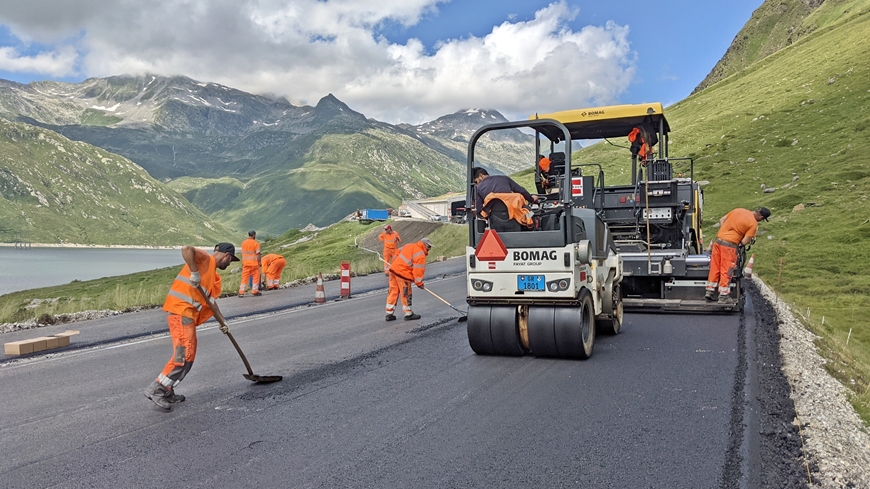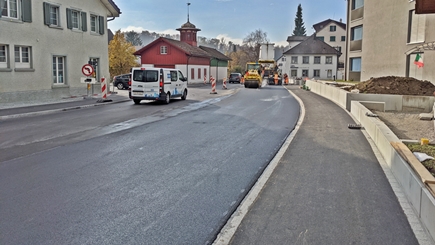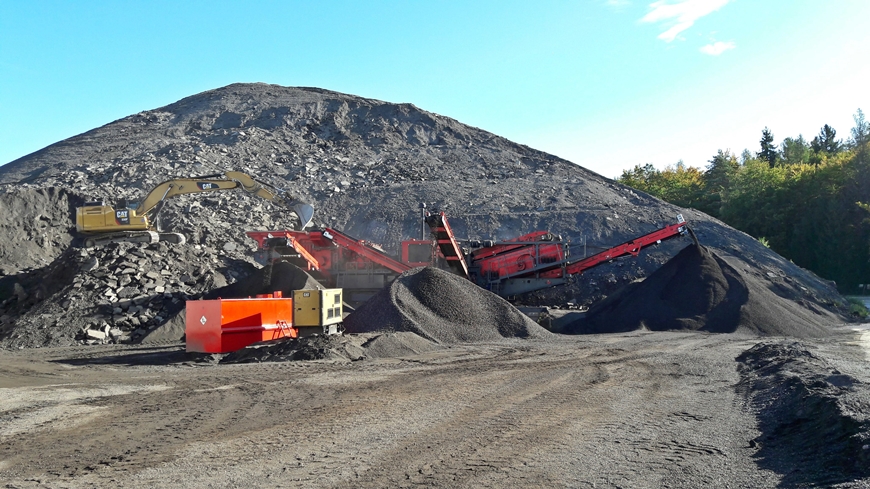Sustainability: Back to the street
Paving the way for more asphalt recycling
Switzerland is built, at least as far as the road network is concerned. Therefore – and despite recycling –, significantly more reclaimed asphalt is generated today than can be reused in new roads. Empa researcher Martins Zaumanis has set himself the goal of increasing the recycled content of asphalt – with adapted production methods and simple instructions. Two test sections with recycled asphalt in Uster and on the Lukmanier Pass are promising.

In spring, not only snowdrops and crocuses sprout, but also construction sites on Swiss roads. Repair work, patching and renewal is everywhere. Some of the old asphalt from the Swiss road network is being recycled, but around 750,000 tons end up in landfills every year, piling up into ever higher black mountains. In principle, the federal government and the cantons, the major road owners, agree: These asphalt mountains should be put back into the Swiss roads. However, Switzerland is so well developed that hardly any new roads are being built.
It is thus all the more important that the proportion of recycled asphalt is as high as possible whenever repairs, patching and renewals are carried out. “But this requires a better understanding of the interaction between reclaimed asphalt and new material, adapted production processes and – above all – practical instructions and tools for the industry,” says Empa researcher Martins Zaumanis. These are precisely the goals of the HighRAP research project, which Zaumanis carried out together with the Federal Roads Office (FEDRO), the Federal Office for the Environment (FOEN), the cantons of Zurich and Graubünden, and several industry partners from 2019 to early 2023.
No consistent material

Asphalt consists of an aggregate mixture and the binder bitumen, which is sometimes modified with polymers for high-load roads. The previous restrictions on the use of reclaimed asphalt pavement (RAP) for the construction of new roads are based primarily on the fact that the binder in the asphalt ages over time and thus becomes stiff. This leads to a susceptibility to cracking. What’s more, the old material may not mix well with the new during the mixing process. Another problem is the frequent lack of homogeneity of RAP: Materials from different road layers and of different ages come together, and different granule sizes meet. However, the production of a high performance asphalt requires continuity. There are proven design methods for mix development and standardized tests for quality control. Only: When adding reclaimed asphalt to existing production processes, the proven methods quickly reach their limits.
In order to increase the RAP content in general, innovations are therefore required at several levels – including the removal of the old asphalt and its processing. Asphalt is usually milled from the road, then crushed. “In the best case, the original aggregate remains intact in the process, and as little dust as possible is produced, so-called filler material,” explains Zaumanis. Because these two factors make reuse difficult. In his study, he presents new criteria based on practical tests that are intended to standardize the characterization of RAP processing and thus simplify the reuse of asphalt. In addition to grain size and dust content, however, the original bitumen content and its properties are crucial and can vary greatly depending on the source. Zaumanis therefore provides a simple calculation model for practitioners that determines the permissible variability depending on the future application.
He also presents a similarly pragmatic calculation model for the dosage of the “rejuvenator”. These are oily substances that soften the old binder in the reclaimed asphalt and thus make it usable again. These rejuvenators are based, for example, on tall oil, a biological by-product from paper production.
The production of asphalt with RAP is significantly more complex than the production of new asphalt due to the large number of different materials and substances that are mixed together. Moreover, there is uncertainty about the actual properties of the materials and how they will interact. “The recipe book approach, as handled in traditional mix design, therefore falls short,” Zaumanis says. Instead, he suggests incorporating performance-based testing methods into the process to examine the material for cracking or plastic deformation.
Real tests on the road

“Ultimately, however, it is mainly successful pilot projects and real test stretches that can give road owners and road builders confidence in asphalt with a high RAP content,” says the Empa researcher. For this reason, HighRAP asphalt has been installed on two road sections as part of his project – on the busy Aathalstrasse in Uster on the one hand, and on the Lukmanierpassstrasse on the other, where the requirements for the road surface are significantly different due to the high altitude.
In Uster, a RAP content of 30% could easily be introduced in the wearing course without any loss of performance. “Typically today, for such a heavily trafficked road, RAP is completely omitted in the wearing course,” explains Zaumanis. For the underlying binder course, Uster showed that between 40 and 50% RAP is feasible. In both cases, asphalt with polymer-modified binder is used as standard. “To increase the RAP content even more, high-polymer modified binder could be used. This would compensate for the lack of polymers in the RAP binder,” Zaumanis says.
In contrast to the road in Uster, the route over the Lukmanier Pass is not exposed to heavy traffic, but to harsher climatic conditions. “At this altitude of 1900 meters, the high temperature fluctuations can cause cracks in the road surface,” says Zaumanis. But in his project, he showed that an asphalt with a high RAP content could also withstand these conditions. An asphalt with 85% RAP content was paved in the foundation layer and an asphalt with 70 % RAP content in the base and binder layers above: without any problems! After tests in the laboratory, the pavements also proved particularly resistant to the feared cracking due to temperature fluctuations.
Long-term observations
The two test sections in Uster and on the Lukmanier Pass will continue to be monitored in the coming years and will be used to study the long-term behavior of RAP asphalt. Martins Zaumanis is already optimistic, however, that the black mountains on the landfills are unlikely to grow too far in the coming years. This is partly because of projects like his, which demonstrates the technological possibilities, but also because calls have already been made at the political level for a landfill ban on reclaimed asphalt. This is intended to increase the incentives for complete recycling of reclaimed asphalt.
Dr. Martins Zaumanis
Concrete & Asphalt
Phone +41 58 765 6075
-
Share






